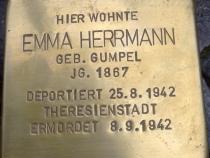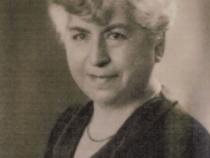Emma Gumpel was born in Lübeck on the 10th of September 1867. Her parents were Falck Salomon and his wife Cecilie, née Bernhardt. Emma’s father was a trader for leather and fashionable accessory.
Emma was the eldest child of the family, five siblings followed:
Salomon, born on the 25th of November 1868, Berthold, born on the 20th of Mai 1870, Julie, born on the 14th of March 1872, Martha, born on the 10th of December 1874 and Hermann, born on the 22nd of March 1876.
Emma, called Esther in her family, married 1881 in Berlin the salesman Salomon Herrmann, who was born on the 19th of November 1853 in Landsberg (on Warthe).
The couple lived in Luckenwalde, where their six children were born: Julie on the 12th of March 1887, Martha on the 27th of June 1889, Fritz on the 17th of November 1890, Heinrich on the 21st of November 1893, Siegfried on the 20th of April 1902 and Kurt on the 24th of December 1903.
1887, one year after marriage, the family lived in Beelitzer Straße 35a at first, 1889 in Wilhelmstraße 9 and finally from 1893 on in Schützenstraße 42a.
Salomon Herrmann was a hat maker and founded a factory in Luckenwalde together with his brother Moritz.
Production of hats was one of the most important sectors of industry of the modern industrial town Luckenwalde. The hat factory Herrmann & co. was founded 1883 and expanded quickly.
The Herrmann family felt the success as an obligation for town and citizens and was engaged for the community of Luckenwalde in many ways: So, Salomon Herrmann was the initiator of the building of the Synagogue of the town and his nephew Gustav – son of Moritz – founded the building society of Luckenwalde. In 1918 the both founded the Salomon-and-Gustav-Herrmann-foundation.
In 1919 Gustav Herrmann met the still unknown architect Erich Mendelsohn in Berlin. He got an engagement to plan the workers’ housing estate by help of Gustav. This estate was built by the building society founded by the Herrmann’s. The family’s garden pavilion was also planned by Erich Mendelsohn in 1920. These were the first important jobs of Mendelsohn.
A long-termed friendship was developed in the following time between the families of Mendelsohn and Herrmann.
After in January 1921 both of the hat factories Steinberg and Herrmann were combined into the biggest hat factory Friedrich Steinberg Herrmann and co. they could realize a new building for their fabrication in the new industrial area. Erich Mendelsohn was assigned to build it.
The new hat factory was built between 1921 and 1923. The building in style of expressionism with the enormous “hat roof” is up to now one of the most prominent examples of modern industrial architecture.
In 1932 Gustav Herrmann faded away. 1934 the company was sold by force.
Parts of the factory building were destroyed and modified. The Mendelson’s hat factory became a listed monument already in 1976 because of its architectural meaning. But not until 2003 was the beginning of reconstruction of the brilliant building and will go ahead for several years.
Salomon Herrmann had given the leadership of the company to his nephew Gustav already in 1919. In the twentieth he had bought an estate in Berlin Dahlem Schorlemerallee 20 and initiated the building of a country house for his large family. In 1926 he became the official owner. Salomon Herrmann died on the 17th of February 1929. With the beginning of the following year his wife Emma and his son Kurt were the owners. In this time Kurt and Heinrich lived together with their mother in the house Schorlemerallee.
Emma Herrmann’s house was sold by force in 1938. In 1939 and 1940 she had to pay “Judenvermögensabgabe” (fee of Jews) and other special fees of 127.000 Reichsmark. At least she had to move as subtenant to a widow Conrad in Prinzregentenstraße 6. From this apartment she was deported to Ghetto Theresienstadt on the 25th of August 1942. There she died on the 8th of September 1942 – two days before her 75th birthday.
(With the transport I/51 100 people were deported to Theresienstadt, eight of them survived.)
The siblings of Emma: Hermann and Julie died early in 1929.
Her brother Salomon was deported to Theresienstadt on the 25th of November 1942 and further on to the extermination camp Treblinka.
Her sister Martha Pinner who was a widow already, committed suicide on the 5th of June 1942.
Her brother Berthold and his wife Martha, née Meinungen, fled with their son Fritz via Switzerland to South France. They were arrested in camp Drancy in 1942 and deported to Auschwitz 1943 where the family was murdered.
Emma’s and Salomon Herrmann’s six children had emigrated:
The eldest daughter Julie was married 1907 in Luckenwalde to Dr. Karl Geisenberg. With the three children Joachim Itzhak, Alice and Hans they emigrated to New York.
Martha was married also in Luckenwalde, in fact 1912 to merchant Otto Markus. With him she emigrated to South America and lived in Montevideo, Uruguay.
Fritz fought in First World War, became sergeant and got the Iron Cross (Eisernes Kreuz). He came into French war captivity in 1917. He married Käthe Rosenthal in 1935 in Berlin. In the pogrom night in November 1938 he was imprisoned in concentration camp Sachsenhausen until the 7th of December. He emigrated to Luxemburg in 1939 and moved to New York in 1950.
Heinrich became director of the company Henkel & co. This was also a hat factory in Luckenwalde. He married Gertrud Borchardt. They got the daughter Helga. Heinrich fought in the First World War too and got the Iron Cross. The family emigrated to New York.
Kurt changed his name to David. He worked as representative in his parent’s company. He married Irma Isacson in 1934. They fled from Berlin-Schöneberg to Australia via Amsterdam and London in 1939. They lived in Melbourne with their two children: Judith-Jenny and Michael-Scholem. He was born in Melbourne 1945.
Siegfried was representative first then he became co-owner in a wholesale house for hats. He married Ruth Jeanette Bermann. Their daughter Susan Lotte was born 1927 in Heilbronn. The family emigrated also to New York. Siegfried changed his name to Stephen. Daughter Susan married Jack Mannheim. They got two Children: Bruce and Linda.
Linda has applied for the stumbling stone which is laid for her Grand Grandmother Emma.
Linda wrote, that her mother Susan has had beautiful memories to her Grandmother. Susan told her daughter Linda that there was a vegetable garden on one side of the house in Heilbronn, and she tried to plant strawberries there. One day, when she came home from school, she found some ripe ones on the ground in the soil. She was immediately sure, that her grandmother, who was visiting them from Berlin, had put them there for her.
And she wrote: „My mother was very very fond of her grandmother and one of the last things my mother did before leaving Germany for the United States was visit her grandmother at her home in Berlin.”
Judi, the daughter of Emma’s youngest son Kurt, who emigrated with his family to Australia, got to know from her father, that the siblings, who emigrated to the USA, had written letters to Eleanor Roosevelt and Cordell Hull, in this time the secretary of state of the United States, to speed up the applied visa for their mother, but in vain.
One can withdraw of a letter of Emma’s attorney in Berlin which was written to her son Kurt in Australia that Emma’s son Siegfried had send an affidavit for his mother and in addition another certificate of bond of a friend. Besides the children of Emma had deposited an amount for the passage for the mother at American Express in New York. With those documents the attorney asked for a new appointment at the consular office to get the visa for Emma. In this letter to Kurt he also made very clear, that the chance to get the visa were very bad and even if they got it, it would be hard to get a free passage to USA.
The visa wasn’t accorded, although Emma had to pay “Reichsfluchtsteuer” (fee for fleeing out of the Reich) about 68.000 Reichsmark.
Kurt wrote also letters to Officials in Canberra, to get a visa for his mother but he was informed that she was too old.
Judi added: “Recently, among some photo albums, I found a letter she had written to me for my fourth birthday in 1941. I had not been aware of the existence of this letter and had no memories of my grandmother, only photos, so the re-emergence of this treasure came as a bolt from the blue, certainly affording me more excitement than when I received it at the age of four!”




